I Connect To This On A Fucking Spiritual Level 😍

I connect to this on a fucking spiritual level 😍
More Posts from Muneaj and Others

my centaur...
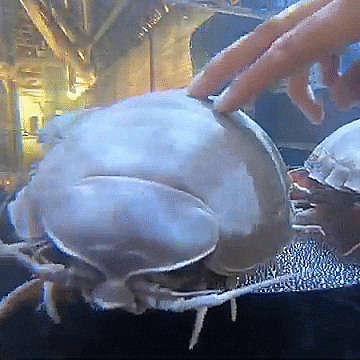

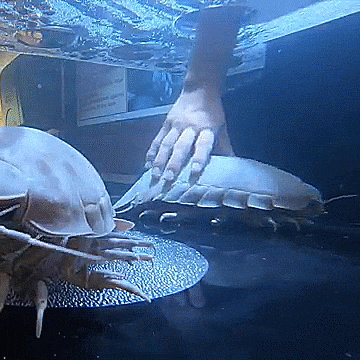
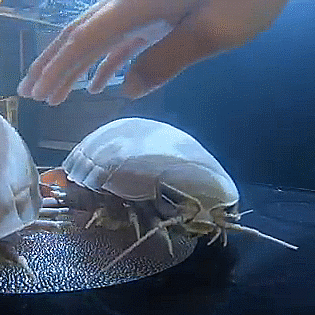
🖤| Florida Keys Aquarium Encounters
SAMINAMINAE E E

Just giving Hunter his wolf sona that he deserves

I'm pretty sure I also posted this on my main acc but I still can't be bothered to search for it lmao An epic commission for @muneaj of their epic dragon god Atlas, what an insanely cool design this is and I was more than happy to draw it!
MY BABY GORLLLLL

my first attack on artfight!!
this adorbs char belongs to one of my best homies!
@muneaj

I hope this guy fucking dies because
A) he's Mr Beast
B) he has WAY too much money if he's renting out the PYRAMIDS OF GIZA????
C) renting out actual historical landmarks that have already been desecrated and destroyed over thousands of years for a goddamn youtube video is actually disgusting.
idk if you think that they're "just the pyramids", they're the ONLY remaining wonder of the ancient world!!! Not to mention!! they're TOMBS!! sure, the people who were inside are long gone, but like?? idk, maybe i'm oversely sensitive, but being a white dude and desecrating an ancient burial site (for profit) and thus disregarding thousands upon thousands of years of history and culture is probably Up There with the scummy stuff this jackass has done
Art Trade with my friend Lunartic_Firefly :D
I also designed the outfit shes wearing cuz she never had one in the first place huehue…

MY SONS MY BABIES MY BOYSSSS THANK U AGAIN BELOVED I KISSS


A commission and a gift for my beloved friend @muneaj of their two OCs Atlas and Astra (wolf version)
I love youuuu
Thank you for supporting me so much and for being the best friend I could ever ask for
These are also two of my most favorite pieces I ever drew and I hope to make many more 💕

How do you do fellow kids

Words for Skin Tone | How to Describe Skin Color
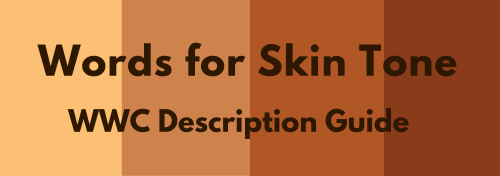
We discussed the issues describing People of Color by means of food in Part I of this guide, which brought rise to even more questions, mostly along the lines of “So, if food’s not an option, what can I use?” Well, I was just getting to that!
This final portion focuses on describing skin tone, with photo and passage examples provided throughout. I hope to cover everything from the use of straight-forward description to the more creatively-inclined, keeping in mind the questions we’ve received on this topic.
Standard Description
Basic Colors

Pictured above: Black, Brown, Beige, White, Pink.
“She had brown skin.”
This is a perfectly fine description that, while not providing the most detail, works well and will never become cliché.
Describing characters’ skin as simply brown or beige works on its own, though it’s not particularly telling just from the range in brown alone.
Complex Colors
These are more rarely used words that actually “mean” their color. Some of these have multiple meanings, so you’ll want to look into those to determine what other associations a word might have.

Pictured above: Umber, Sepia, Ochre, Russet, Terra-cotta, Gold, Tawny, Taupe, Khaki, Fawn.
Complex colors work well alone, though often pair well with a basic color in regards to narrowing down shade/tone.
For example: Golden brown, russet brown, tawny beige…
As some of these are on the “rare” side, sliding in a definition of the word within the sentence itself may help readers who are unfamiliar with the term visualize the color without seeking a dictionary.
“He was tall and slim, his skin a russet, reddish-brown.”
Comparisons to familiar colors or visuals are also helpful:
“His skin was an ochre color, much like the mellow-brown light that bathed the forest.”
Modifiers
Modifiers, often adjectives, make partial changes to a word.The following words are descriptors in reference to skin tone.
Dark - Deep - Rich - Cool
Warm - Medium - Tan
Fair - Light - Pale
Rich Black, Dark brown, Warm beige, Pale pink…
If you’re looking to get more specific than “brown,” modifiers narrow down shade further.
Keep in mind that these modifiers are not exactly colors.
As an already brown-skinned person, I get tan from a lot of sun and resultingly become a darker, deeper brown. I turn a pale, more yellow-brown in the winter.
While best used in combination with a color, I suppose words like “tan” “fair” and “light” do work alone; just note that tan is less likely to be taken for “naturally tan” and much more likely a tanned White person.
Calling someone “dark” as description on its own is offensive to some and also ambiguous. (See: Describing Skin as Dark)
Undertones
Undertones are the colors beneath the skin, seeing as skin isn’t just one even color but has more subdued tones within the dominating palette.
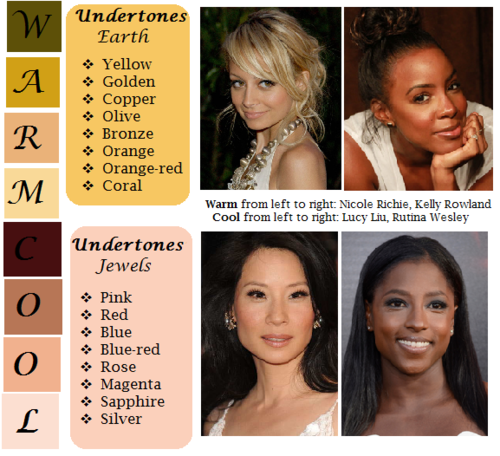
pictured above: warm / earth undertones: yellow, golden, copper, olive, bronze, orange, orange-red, coral | cool / jewel undertones: pink, red, blue, blue-red, rose, magenta, sapphire, silver.
Mentioning the undertones within a character’s skin is an even more precise way to denote skin tone.
As shown, there’s a difference between say, brown skin with warm orange-red undertones (Kelly Rowland) and brown skin with cool, jewel undertones (Rutina Wesley).
“A dazzling smile revealed the bronze glow at her cheeks.”
“He always looked as if he’d ran a mile, a constant tinge of pink under his tawny skin.”
Standard Description Passage
“Farah’s skin, always fawn, had burned and freckled under the summer’s sun. Even at the cusp of autumn, an uneven tan clung to her skin like burrs. So unlike the smooth, red-brown ochre of her mother, which the sun had richened to a blessing.”
-From my story “Where Summer Ends” featured in Strange Little Girls
Here the state of skin also gives insight on character.
Note my use of “fawn” in regards to multiple meaning and association. While fawn is a color, it’s also a small, timid deer, which describes this very traumatized character of mine perfectly.
Though I use standard descriptions of skin tone more in my writing, at the same time I’m no stranger to creative descriptions, and do enjoy the occasional artsy detail of a character.
Creative Description
Whether compared to night-cast rivers or day’s first light…I actually enjoy seeing Characters of Colors dressed in artful detail.
I’ve read loads of descriptions in my day of white characters and their “smooth rose-tinged ivory skin”, while the PoC, if there, are reduced to something from a candy bowl or a Starbucks drink, so to actually read of PoC described in lavish detail can be somewhat of a treat.
Still, be mindful when you get creative with your character descriptions. Too many frills can become purple-prose-like, so do what feels right for your writing when and where. Not every character or scene warrants a creative description, either. Especially if they’re not even a secondary character.
Using a combination of color descriptions from standard to creative is probably a better method than straight creative. But again, do what’s good for your tale.
Natural Settings - Sky

Pictured above: Harvest Moon -Twilight, Fall/Autumn Leaves, Clay, Desert/Sahara, Sunlight - Sunrise - Sunset - Afterglow - Dawn- Day- Daybreak, Field - Prairie - Wheat, Mountain/Cliff, Beach/Sand/Straw/Hay.
Now before you run off to compare your heroine’s skin to the harvest moon or a cliff side, think about the associations to your words.
When I think cliff, I think of jagged, perilous, rough. I hear sand and picture grainy, yet smooth. Calm. mellow.
So consider your character and what you see fit to compare them to.
Also consider whose perspective you’re describing them from. Someone describing a person they revere or admire may have a more pleasant, loftier description than someone who can’t stand the person.
“Her face was like the fire-gold glow of dawn, lifting my gaze, drawing me in.”
“She had a sandy complexion, smooth and tawny.”
Even creative descriptions tend to draw help from your standard words.
Flowers
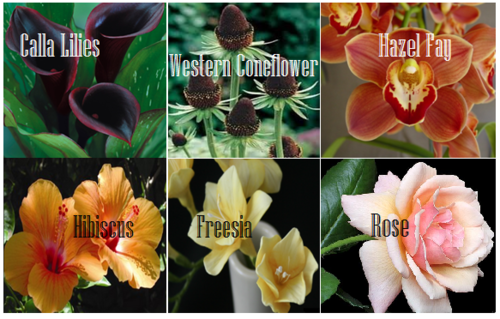
Pictured above: Calla lilies, Western Coneflower, Hazel Fay, Hibiscus, Freesia, Rose
It was a bit difficult to find flowers to my liking that didn’t have a 20 character name or wasn’t called something like “chocolate silk” so these are the finalists.
You’ll definitely want to avoid purple-prose here.
Also be aware of flowers that most might’ve never heard of. Roses are easy, as most know the look and coloring(s) of this plant. But Western coneflowers? Calla lilies? Maybe not so much.
“He entered the cottage in a huff, cheeks a blushing brown like the flowers Nana planted right under my window. Hazel Fay she called them, was it?”
Assorted Plants & Nature

Pictured above: Cattails, Seashell, Driftwood, Pinecone, Acorn, Amber
These ones are kinda odd. Perhaps because I’ve never seen these in comparison to skin tone, With the exception of amber.
At least they’re common enough that most may have an idea what you’re talking about at the mention of “pinecone."
I suggest reading out your sentences aloud to get a better feel of how it’ll sounds.
"Auburn hair swept past pointed ears, set around a face like an acorn both in shape and shade.”
I pictured some tree-dwelling being or person from a fantasy world in this example, which makes the comparison more appropriate.
I don’t suggest using a comparison just “cuz you can” but actually being thoughtful about what you’re comparing your character to and how it applies to your character and/or setting.
Wood

Pictured above: Mahogany, Walnut, Chestnut, Golden Oak, Ash
Wood can be an iffy description for skin tone. Not only due to several of them having “foody” terminology within their names, but again, associations.
Some people would prefer not to compare/be compared to wood at all, so get opinions, try it aloud, and make sure it’s appropriate to the character if you do use it.
“The old warlock’s skin was a deep shade of mahogany, his stare serious and firm as it held mine.”
Metals

Pictured above: Platinum, Copper, Brass, Gold, Bronze
Copper skin, brass-colored skin, golden skin…
I’ve even heard variations of these used before by comparison to an object of the same properties/coloring, such as penny for copper.
These also work well with modifiers.
“The dress of fine white silks popped against the deep bronze of her skin.”
Gemstones - Minerals
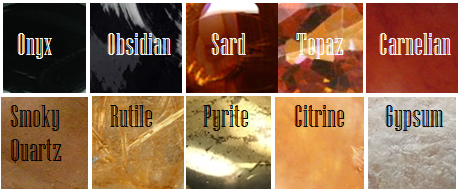
Pictured above: Onyx, Obsidian, Sard, Topaz, Carnelian, Smoky Quartz, Rutile, Pyrite, Citrine, Gypsum
These are trickier to use. As with some complex colors, the writer will have to get us to understand what most of these look like.
If you use these, or any more rare description, consider if it actually “fits” the book or scene.
Even if you’re able to get us to picture what “rutile” looks like, why are you using this description as opposed to something else? Have that answer for yourself.
“His skin reminded her of the topaz ring her father wore at his finger, a gleaming stone of brown, mellow facades.”
Physical Description
Physical character description can be more than skin tone.
Show us hair, eyes, noses, mouth, hands…body posture, body shape, skin texture… though not necessarily all of those nor at once.
Describing features also helps indicate race, especially if your character has some traits common within the race they are, such as afro hair to a Black character.
How comprehensive you decide to get is up to you. I wouldn’t overdo it and get specific to every mole and birthmark. Noting defining characteristics is good, though, like slightly spaced front teeth, curls that stay flopping in their face, hands freckled with sunspots…
General Tips
Indicate Race Early: I suggest indicators of race be made at the earliest convenience within the writing, with more hints threaded throughout here and there.
Get Creative On Your Own: Obviously, I couldn’t cover every proper color or comparison in which has been “approved” to use for your characters’ skin color, so it’s up to you to use discretion when seeking other ways and shades to describe skin tone.
Skin Color May Not Be Enough: Describing skin tone isn’t always enough to indicate someone’s ethnicity. As timeless cases with readers equating brown to “dark white” or something, more indicators of race may be needed.
Describe White characters and PoC Alike: You should describe the race and/or skin tone of your white characters just as you do your Characters of Color. If you don’t, you risk implying that White is the default human being and PoC are the “Other”).
PSA: Don’t use “Colored.” Based on some asks we’ve received using this word, I’d like to say that unless you or your character is a racist grandmama from the 1960s, do not call People of Color “colored” please.
Not Sure Where to Start? You really can’t go wrong using basic colors for your skin descriptions. It’s actually what many people prefer and works best for most writing. Personally, I tend to describe my characters using a combo of basic colors + modifiers, with mentions of undertones at times. I do like to veer into more creative descriptions on occasion.
Want some alternatives to “skin” or “skin color”? Try: Appearance, blend, blush, cast, coloring, complexion, flush, glow, hue, overtone, palette, pigmentation, rinse, shade, sheen, spectrum, tinge, tint, tone, undertone, value, wash.
Skin Tone Resources
List of Color Names
The Color Thesaurus
Skin Undertone & Color Matching
Tips and Words on Describing Skin
Photos: Undertones Described (Modifiers included)
Online Thesaurus (try colors, such as “red” & “brown”)
Don’t Call me Pastries: Creative Skin Tones w/ pics I
Writing & Description Guides
WWC Featured Description Posts
WWC Guide: Words to Describe Hair
Writing with Color: Description & Skin Color Tags
7 Offensive Mistakes Well-intentioned Writers Make
I tried to be as comprehensive as possible with this guide, but if you have a question regarding describing skin color that hasn’t been answered within part I or II of this guide, or have more questions after reading this post, feel free to ask!
~ Mod Colette
-
 daemonfinder liked this · 2 years ago
daemonfinder liked this · 2 years ago -
 voidvendetta liked this · 2 years ago
voidvendetta liked this · 2 years ago -
 freaky-void liked this · 2 years ago
freaky-void liked this · 2 years ago -
 muneaj reblogged this · 2 years ago
muneaj reblogged this · 2 years ago -
 ask-red-and-solomon liked this · 3 years ago
ask-red-and-solomon liked this · 3 years ago -
 balou200 reblogged this · 3 years ago
balou200 reblogged this · 3 years ago -
 balou200 liked this · 3 years ago
balou200 liked this · 3 years ago -
 luna-melon liked this · 4 years ago
luna-melon liked this · 4 years ago -
 our-wishes-and-whispers reblogged this · 4 years ago
our-wishes-and-whispers reblogged this · 4 years ago -
 tinkerbelldetective liked this · 5 years ago
tinkerbelldetective liked this · 5 years ago -
 nanana-deactivated liked this · 5 years ago
nanana-deactivated liked this · 5 years ago -
 wind-riders liked this · 5 years ago
wind-riders liked this · 5 years ago -
 queenpanpan liked this · 5 years ago
queenpanpan liked this · 5 years ago -
 figuringoutlifenstuffs reblogged this · 5 years ago
figuringoutlifenstuffs reblogged this · 5 years ago -
 figuringoutlifenstuffs liked this · 5 years ago
figuringoutlifenstuffs liked this · 5 years ago -
 honeydroid liked this · 6 years ago
honeydroid liked this · 6 years ago -
 shantalangel reblogged this · 6 years ago
shantalangel reblogged this · 6 years ago -
 shantalangel liked this · 6 years ago
shantalangel liked this · 6 years ago -
 nemo-draco reblogged this · 6 years ago
nemo-draco reblogged this · 6 years ago -
 nemo-draco liked this · 6 years ago
nemo-draco liked this · 6 years ago -
 lycriza reblogged this · 6 years ago
lycriza reblogged this · 6 years ago -
 beautifuldiplomatdreamtree-blog liked this · 6 years ago
beautifuldiplomatdreamtree-blog liked this · 6 years ago -
 l0rna-wh0re reblogged this · 6 years ago
l0rna-wh0re reblogged this · 6 years ago -
 systemf4ilure liked this · 6 years ago
systemf4ilure liked this · 6 years ago -
 jhinenjaycencia liked this · 6 years ago
jhinenjaycencia liked this · 6 years ago -
 hopeweaving liked this · 6 years ago
hopeweaving liked this · 6 years ago -
 earthnashes liked this · 6 years ago
earthnashes liked this · 6 years ago -
 neon-flamingo liked this · 6 years ago
neon-flamingo liked this · 6 years ago -
 seirei-bh liked this · 6 years ago
seirei-bh liked this · 6 years ago -
 melthehoneybee liked this · 6 years ago
melthehoneybee liked this · 6 years ago -
 alekunpower liked this · 6 years ago
alekunpower liked this · 6 years ago -
 catgirlwarrior liked this · 6 years ago
catgirlwarrior liked this · 6 years ago -
 bluebeetletedkord liked this · 6 years ago
bluebeetletedkord liked this · 6 years ago -
 xpanicattackx reblogged this · 6 years ago
xpanicattackx reblogged this · 6 years ago -
 blubahblub reblogged this · 6 years ago
blubahblub reblogged this · 6 years ago -
 chessgrins reblogged this · 6 years ago
chessgrins reblogged this · 6 years ago -
 curlyfrostviking liked this · 6 years ago
curlyfrostviking liked this · 6 years ago -
 multifaceted-diamond liked this · 6 years ago
multifaceted-diamond liked this · 6 years ago -
 aquanna-alight liked this · 6 years ago
aquanna-alight liked this · 6 years ago -
 the-purple-hero reblogged this · 6 years ago
the-purple-hero reblogged this · 6 years ago -
 camrii reblogged this · 6 years ago
camrii reblogged this · 6 years ago -
 hormonalcroutans-blog liked this · 6 years ago
hormonalcroutans-blog liked this · 6 years ago -
 gearr-gausapo reblogged this · 6 years ago
gearr-gausapo reblogged this · 6 years ago -
 nancyesberry reblogged this · 6 years ago
nancyesberry reblogged this · 6 years ago -
 fallencor liked this · 6 years ago
fallencor liked this · 6 years ago -
 lovemecutie reblogged this · 6 years ago
lovemecutie reblogged this · 6 years ago

AroAce wins the race⭐ 🎏-|Banner:Me /Pfp: Me.•* 🍓Aro/Ace💐🇭🇷/Artist-Animator🌾''i draw whatever i feel like drawing''
164 posts